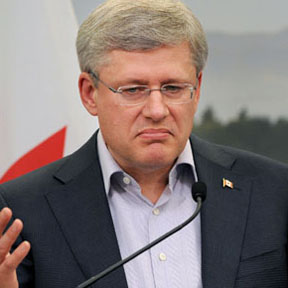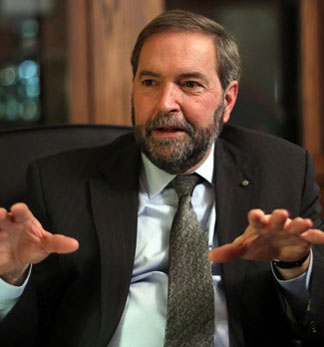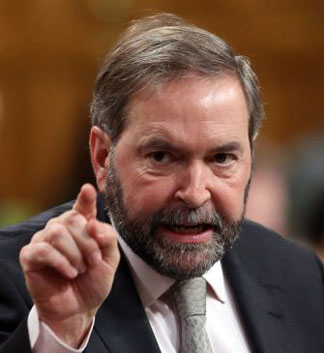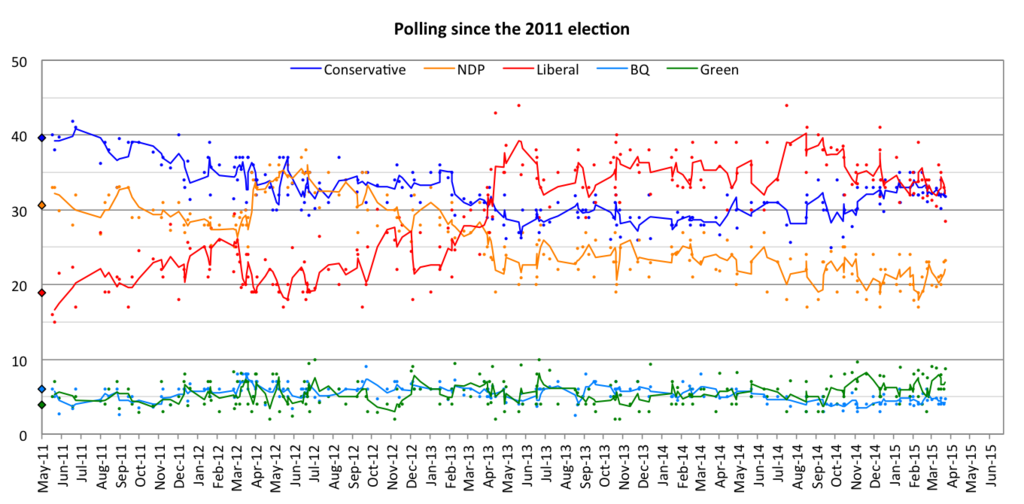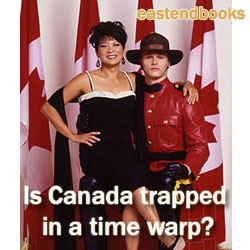Of course as current third party the NDP is bound to talk up some kind of Liberal-NDP co-operation, but ..
Apr 3rd, 2015 | By Randall White | Category: Ottawa Scene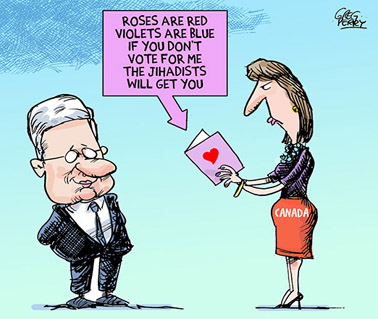
Interesting cartoon by Greg Perry in The Tyee, 16 Feb 2015, accompanying Rafe Mair’s thoughts on “Is Harper pushing us towards a new McCarthyism?”
Moving into the second quarter of 2015 may remind political junkies that the much anticipated Canadian federal election this year will probably come in the early fourth quarter.
So, as some wise guys argue, the election is still six months away. Things looked different six months ago than they do now. Who knows just how the world will appear to the diverse  middle-class masses actually interested in voting on election day  (now ?almost certainly? Monday, October 19, 2015) ?
For we junkies at least, the game is nonetheless already too intriguing to stop playing, even for a sensible moment. And it’s now being played a bit more seriously than at the start of the year.
The current state of the art is wondering if “Tom” Mulcair and the New Democrats are gaining ground. See, eg, Éric Grenier’s “Tom Mulcair’s NDP may be turning a corner, polls suggest … With recent uptick, the New Democrats seem to be back in the game,” on the CBC News site.

British Columbia NDP MLA Jenny Kwan will be running for the federal NDP in Vancouver East in the 2015 election : “What we need is someone who is fearless in Ottawa to take on the Prime Minister ... and I'm not afraid to take on Stephen Harper.”
Meanwhile, back on the CTV site, the latest more inscrutable news is “Liberals score higher on Nanos Index as Harper numbers slip.”
You might read the sum of all this as bad news for the Harper Con party. But it could be just the opposite.
On election day there may be more than a few seats where over-exuberant Liberal-NDP contests let Conservatives, as it were, win by default, with quite low percentages of the total local vote.
Both this prospect and recent polling numbers do seem to be raising some quiet and still inevitably twisted  interest in some form of Liberal-New Democrat (or New Democrat-Liberal) co-operation, that could, as the rhetoric would have it, put an effective end to the dark spell Stephen Harper has cast over Canadian federal politics.
Éric Grenier’s current polling averages have the federal Liberals and Conservatives tied at about 32% of the Canada-wide popular vote each – with the NDP at 22% (and the Greens at 7% and the BQ at 19% in Quebec, just behind the Conservatives in Quebec at 21%).
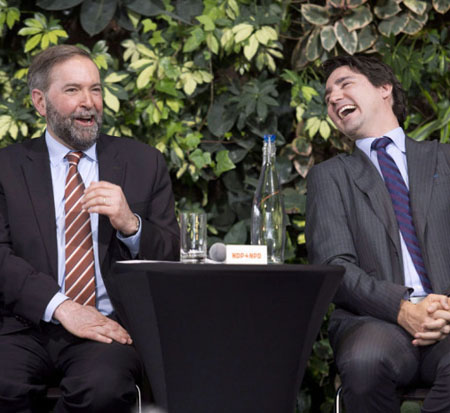
What fun a progressive coalition in Ottawa would be! And no more pushing towards a new McCarthyism! THE CANADIAN PRESS/Adrian Wyld.
Yet Grenier’s seat projection from these popular vote numbers still gives the Conservatives 143 seats to the Liberals’ 117 and the New Democrats’ 73 (with 3 BQ and 2 Green).
Even so, in a new 338-seat Canadian House of Commons, where 170 seats is a bare majority, the biggest news in Grenier’s and other current cross-Canada polling numbers is that no party currently seems headed for anything like a majority government.
Similarly, if the current numbers actually did prevail on October 19, and the Harper Conservatives did try to carry on governing with a mere 143 seats in the Canadian House of Commons, they could easily be defeated and then replaced by a new majority-governing alliance of 190 Liberals and New Democrats. (And is anyone really going to be terrified by Stephen Harper’s “coalition” scare-mongering this time? Democracy in our system means whoever can command a majority in the duly elected parliament gets to form the government. Period. Mr. Harper should read Walter Bagehot on The English Constitution – first published in 1867, the same year as Canadian confederation.)
* * * *
This context lends special interest to Brian Topp’s March 30 op-ed piece, in the Toronto Star and a few related places, on “The lessons of Danielle Smith’s political self-destruction … If the federal NDP and Liberals ever hope to attempt some formal partnership, they would be wise to study the case of Danielle Smith”
Brian Topp is both “a former president and national campaign director of the New Democratic Party of Canada” and a former federal NDP leadership candidate.
It is at least intriguing when someone with credentials of this sort writes in a newspaper article that “there can be circumstances in which it is both smart and right for parties to find some kind of formal common ground … For example – possibly – in a new minority federal parliament after the coming October federal election, which would present a new majority in Parliament with an opportunity to finally put the Harper government in its grave … Which are circumstances, as Danielle Smith has just taught us, that require a considerably more hard-headed and detailed attention to one’s long-term interests, leverage, risks and goals.”
It was not long ago as well that federal NDP leader Thomas Mulcair was indulging in parallel musings in public. Just this past March 17 it was reported that :“The NDP leader said this year’s election should be a three-way battle from the outset, paving the way for a social democratic government … But if the Tories were to return, Mulcair has said a post-election alliance with the Liberals could be necessary.”
On the same day the Huffington Post also reported that : “Over the past few weeks, Mulcair has repeatedly floated the possibility of forming a coalition with the Grits … It’s a strategy designed to ward off voters who think they need to vote Liberal in order to avoid another Stephen Harper Conservative government, an NDP strategist said … Mulcair suggested in Montreal on Tuesday that the NDP would be willing to form a coalition with the Liberals in order to replace the Tories … Two weeks ago, he told 300 people at a town hall Q&A session in Nanaimo, BC, that he had raised the possibility but that the Liberal leader had thumbed his nose at it.”
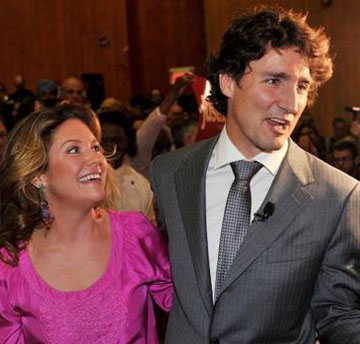
Some will ask : why aren’t the Liberals making more use of the lovely Sophie Gregoire? Paul Chiasson/THE CANADIAN PRESS.
But : “Liberal Leader Justin Trudeau’s office says NDP Leader Thomas Mulcair is lying about a discussion he claims the two leaders had last year about forming a coalition … Trudeau, who has ruled out forming a coalition with the NDP, says a meeting that Mulcair says happened at the Irish Embassy never occurred.”
So … if there is going to be any kind of new Liberal-NDP progressive governing alliance after the next federal election in October, it will of course be far from easy. As Mr. Topp has just said, it will “require a considerably more hard-headed and detailed attention to one’s long-term interests, leverage, risks and goals” than Danielle Smith showed in her recent attempt to bring the heart of the Wildrose Party into the mainstream Alberta PCs.
Here as elsewhere, however, necessity is the mother of invention. And to many among we unwashed mere progressive voters, the current polling numbers do seem to confirm that the most likely way ahead for the cause of progress in Canada right now will lie in some practical policy of Liberal-New Democrat co-operation in Ottawa.
If recent NDP musings in this direction are just a strategy designed to attract Liberals who really want to avoid another Stephen Harper Conservative government, the strategy may be working.
Personally, I think the Liberals should start fighting back by giving New Democrats some of their own medicine! As in, eg: “this year’s election should be a three-way battle, paving the way for peace, order, and good Liberal government once again … But if no party has a majority of seats when all the votes are counted, a post-election alliance with the New Democrats could be necessary.”
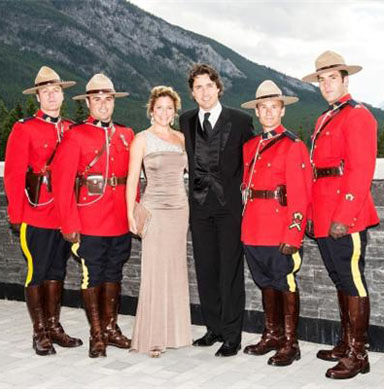
Sophie and Justin at the Banff Centre Midsummer Ball, August 2013. A new Mr. & Mrs. Canada/M. et Mme Canada? With Uncle Tom as Deputy PM (or even the other way around????)
Meanwhile, there is almost certainly much deep political wisdom to be gained from gazing at the following chart with which I am ending here – gleaned from a quite excellent Wikipedia article called “Opinion polling for the 42nd Canadian federal election.”
Both the chart and the article itself, which provides a useful “list of scientific, nation-wide public opinion polls that have been conducted since the 2011 Canadian federal election and leading up to the 42nd Canadian federal election” in 2015, show just how much cross-Canada popular opinion about Canadian federal political parties has varied over the past four years. And it is no doubt true enough that it could vary still more over the next six months. The coming (probably October 19?) federal election actually does seem interesting right now, because in one important sense or another it really does (well, almost) appear to be anyone’s game to loose, among the three major parties at least.
